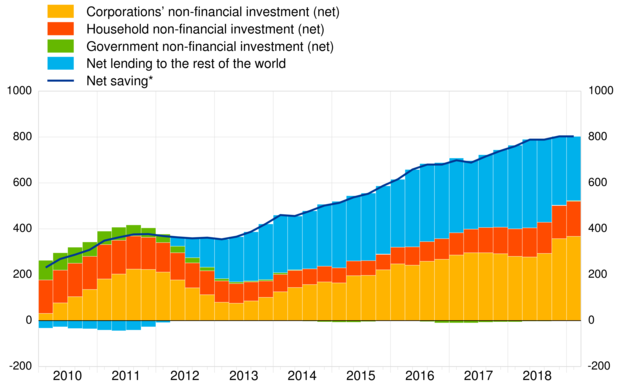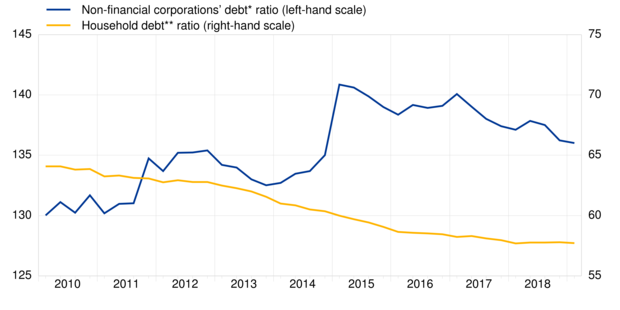- PRESS RELEASE
- 26 July 2019
Euro area economic and financial developments by institutional sector: first quarter of 2019
- Euro area net saving was broadly unchanged at €793 billion in the four quarters to the first quarter of 2019. Euro area net non-financial investment increased to €523 billion (from €503 billion in the previous quarter), due to increased investments by households and non-financial corporations. Euro area net lending to the rest of the world decreased to €280 billion (from €301 billion in the previous quarter).
- The household debt-to-income ratio[1] continued to decrease, to 93.1% in the first quarter of 2019 from 93.5% in the first quarter of 2018. Non-financial corporation debt declined to 136.0% of GDP, from 137.1% one year ago.
Total euro area economy
Euro area net saving was broadly unchanged at €793 billion (8.4% of euro area net disposable income) in the four quarters to the first quarter of 2019. Euro area net non-financial investment increased to €523 billion (5.5% of net disposable income), owing to increased investments by households and non-financial corporations.
Euro area net lending to the rest of the world decreased to €280 billion (from €301 billion in the previous quarter) reflecting the increased net non-financial investment and broadly unchanged net saving. Net lending by non-financial corporations decreased from €59 billion to €36 billion (0.4% of euro area net disposable income) and net lending by financial corporations decreased from €106 billion to €97 billion (1.0% of net disposable income). Net lending by households increased from €197 billion to €223 billion (2.4% of net disposable income). The decrease in net lending by the private sector as a whole was accompanied by an increase in net borrowing by the government sector (-0.8% of net disposable income, compared with -0.6% in the four quarters to the previous quarter).
Chart 1. Euro area saving, investment and net lending to the rest of the world
(EUR billions, four-quarter sums) * Net saving minus net capital transfers to the rest of the world (equals change in net worth due to transactions).
Households
The annual growth rate of household financial investment increased to 2.2% in the first quarter of 2019, from 2.0% in the previous quarter. Accelerating investment in currency and deposits, and a reduction in the net sales of debt securities were only partially offset by disinvestment in shares and other equity.
Households continued to sell debt securities (in net terms) issued by MFIs and other financial institutions (albeit at a slower pace), while they accelerated buying debt securities issued by general government. At the same time, households became overall net sellers of investment fund shares and listed shares. Regarding the latter, they were net sellers of listed shares of non-financial-corporations, and net buyers of listed shares of MFIs and other financial institutions. (see Table 1 below and Table 2.2. in the Annex).
The household debt-to-income ratio[2] continued to decrease, to 93.1% in the first quarter of 2019 from 93.5% in the first quarter of 2018, as disposable income grew faster than the outstanding amount of loans to households. The household debt-to-GDP ratio stood unchanged at 57.7% in the first quarter of 2019 (see Chart 2).
Table 1. Financial investments and financing of households, main items
(annual growth rates)
Financial transactions |
|||||
2018 Q1 |
2018 Q2 |
2018 Q3 |
2018 Q4 |
2019 Q1 |
|
Financial investment* |
2.0 |
2.0 |
2.0 |
2.0 |
2.2 |
Currency and deposits |
3.3 |
3.7 |
3.7 |
4.0 |
4.9 |
Debt securities |
-13.2 |
-8.3 |
-4.0 |
-3.2 |
-0.3 |
Shares and other equity |
2.0 |
0.9 |
0.4 |
0.0 |
-0.7 |
Investment fund shares |
6.0 |
3.4 |
2.4 |
0.3 |
-1.4 |
Life insurance and pension schemes |
2.3 |
2.3 |
2.3 |
2.2 |
2.2 |
Financing** |
2.9 |
3.2 |
3.3 |
3.6 |
3.7 |
Loans |
3.0 |
3.1 |
3.1 |
3.2 |
3.3 |
* Items not shown include: loans granted, prepayments of insurance premiums and reserves for outstanding claims and other accounts receivable.** Items not shown include: financial derivative's net liabilities, pension schemes and other accounts payable.
Chart 2. Debt ratios of households and non-financial corporations
(debt as a percentage of GDP) * Outstanding amount of loans, debt securities, trade credits and pension scheme liabilities. ** Outstanding amount of loan liabilities.
Non-financial corporations
In the first quarter of 2019, the annual growth of financing of non-financial corporations stood at an unchanged rate of 1.3% compared with the previous quarter, reflecting in particular increased financing by shares and other equity, offset by a deceleration in the growth of financing by debt securities and loans (see Table 2 below). The annual growth rate of loan financing decreased to 0.9% from 2.0% in the previous quarter, reflecting a decrease in the growth rate of loans granted by all counterpart sectors (see Table 3.2. in the Annex).
Non-financial corporations' debt-to-GDP ratio decreased to 136.0% in the first quarter of 2019, from 137.1% in the first quarter of 2018 (see chart 2).
Table 2. Financial investments and financing of non-financial corporations, main items
(annual growth rates)
Financial transactions |
|||||
2018 Q1 |
2018 Q2 |
2018 Q3 |
2018 Q4 |
2019 Q1 |
|
Financing* |
1.8 |
1.8 |
1.6 |
1.3 |
1.3 |
Debt securities |
5.6 |
5.8 |
5.7 |
4.5 |
4.0 |
Loans |
2.3 |
2.5 |
2.7 |
2.0 |
0.9 |
Shares and other equity |
1.0 |
0.8 |
0.6 |
0.6 |
0.8 |
Trade credits and advances |
5.1 |
5.6 |
4.5 |
3.1 |
3.1 |
Financial investment** |
3.0 |
3.1 |
2.7 |
2.0 |
1.8 |
Currency and deposits |
4.8 |
5.6 |
5.0 |
4.3 |
5.2 |
Debt securities |
-11.6 |
-5.7 |
-7.2 |
-0.6 |
-4.3 |
Loans |
3.9 |
2.7 |
2.2 |
0.2 |
-0.8 |
Shares and other equity |
1.5 |
1.7 |
1.8 |
1.6 |
1.7 |
* Items not shown include: pension schemes, other accounts payable, financial derivative's net liabilities and deposits.** Items not shown include: other accounts receivable and prepayments of insurance premiums and reserves for outstanding claims.
Annexes
For media queries, please contact Stefan Ruhkamp, tel.: +49 69 1344 5057.
Notes
- These data come from a second release of quarterly euro area sector accounts from the European Central Bank (ECB) and Eurostat, the statistical office of the European Union. This release incorporates revisions and completed data for all sectors compared with the first quarterly release on "Euro area households and non-financial corporations" of 3 July 2019.
- The debt-to-GDP (or debt-to-income) ratios are calculated as the outstanding amount of debt in the reference quarter divided by the sum of GDP (or income) in the four quarters to the reference quarter. The ratio of non-financial transactions (e.g. savings) as a percentage of income or GDP is calculated as sum of the four quarters to the reference quarter for both numerator and denominator.
- The annual growth rate of non-financial transactions and of outstanding assets and liabilities (stocks) is calculated as the percentage change between the value for a given quarter and that value recorded four quarters earlier. The annual growth rates used for financial transactions refer to the total value of transactions during the year in relation to the outstanding stock a year before.
- The next release of the Household Sector Report containing results for the euro area and all EU countries is scheduled for 7 August 2019.
- Hyperlinks in the main body of the press release lead to data that may change with subsequent releases as a result of revisions. Figures shown in annex tables are a snapshot of the data as at the time of the current release.
- [1]Calculated as loans divided by gross disposable income.
- [2]Calculated as loans divided by gross disposable income.
European Central Bank
Directorate General Communications
- Sonnemannstrasse 20
- 60314 Frankfurt am Main, Germany
- +49 69 1344 7455
- media@ecb.europa.eu
Reproduction is permitted provided that the source is acknowledged.
Media contacts

